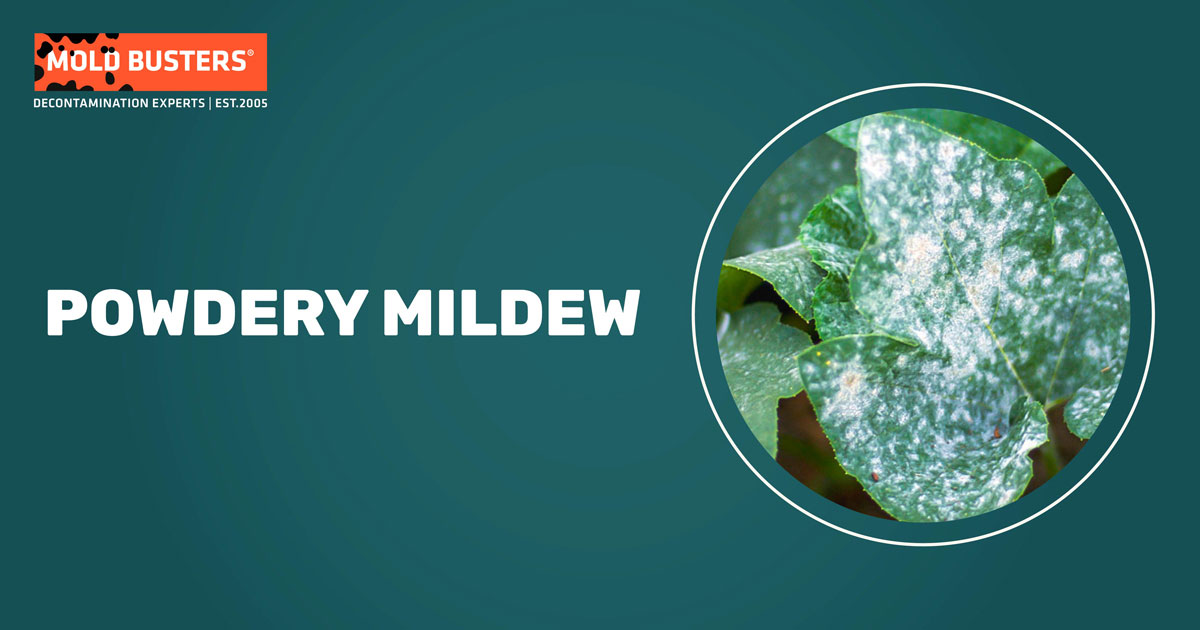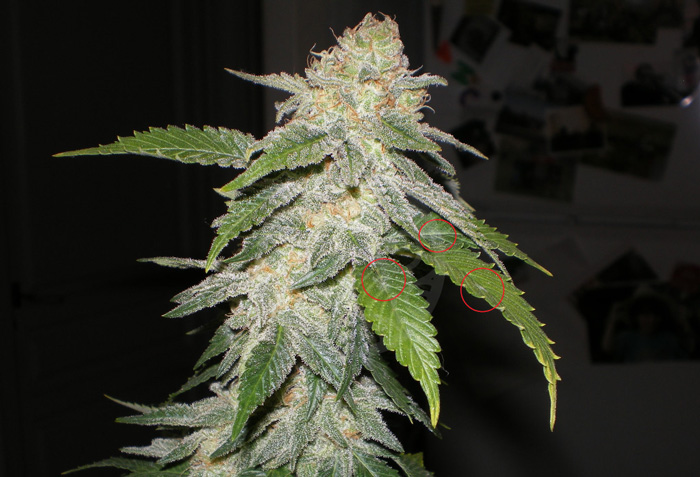Powdery Mildew
Since the dawn of civilization, the practice of growing and cultivating plants has played a major role in people’s lives. Throughout history, thousands of different plants have been used to feed and heal all nations in all parts of the world.
But growing plants has never been easy. Facing so many parasites and other enemies of plants, growers always had to stay alert in order to prevent the fruits of their labour from being contaminated and destroyed.
After all, their lives and the lives of their loved ones depended on the health of their crops, so they had to give their best to keep their plants in good condition.
Even today, with all the pesticides, herbicides and technologies we have at hand, plants fall victim to various diseases and parasites. Among the dangers that always lurk is powdery mildew – a silent killer of many plants.
If you’re in Montreal or Ottawa, our team can help you identify and deal with powdery mildew.
Contents
What is powdery mildew?
Powdery mildew, also known as white mold, is a fungal disease that can affect a number of plants.
It is caused by various species of Erysiphales fungi, the most common reported cause being Podosphaera xanthii (also known as Sphaerotheca fuliginea) and Oidium. Different species will infest different plants with similar symptoms appearing on all of them.
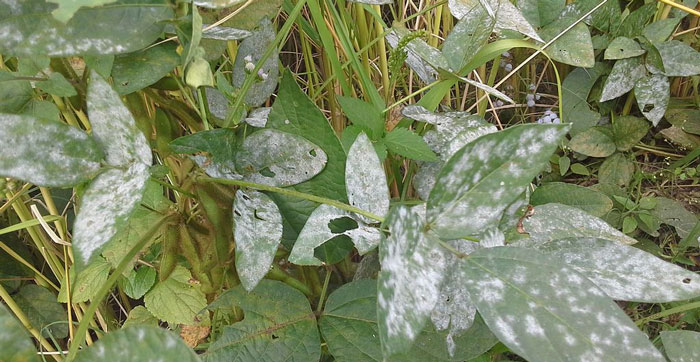
In most cases, spores spread via the air inside and around areas where the plants are growing. However, they can occasionally be spread by coming into contact with tools, animals or humans brushing against the plants.
This fungus reproduces incredibly quickly (both sexually and asexually), so if you don’t recognize it on time, it can destroy your entire crop. Luckily, anyone who regularly checks their plants can easily notice a contamination and take steps to prevent it from spreading.
In an agricultural setting, powdery mildew can be controlled using different chemical methods, genetic resistance and careful farming methods. We will go over some of these methods later in the article.
We offer mold inspection and mold testing services in Montreal and Ottawa to help you identify and control such issues.
What does powdery mildew look like?
Powdery mildew is fairly easy to identify as its symptoms are quite distinctive:
- On infected plants, you will see white, powder-like circular patches (hence the name powdery mildew) on the leaves and stems.
- Usually, the lower leaves will be the most affected, but spots can also appear on any part of the plant that’s above the ground.
- Powdery mildew generally covers the upper side of the leaves, but it can also grow on the undersides.
- Young foliage is most frequently affected. Leaves turn yellow and dry out.
- The spores will get larger and thicker as the disease spreads, often forming a solid mat over the entire infected surface.
- Late in the growing season, the plant’s leaves, buds and growing tips will all become disfigured.
- In case of severe infections, you can expect stunted and distorted foliage, leaf drop and even fatal consequences on some plants.
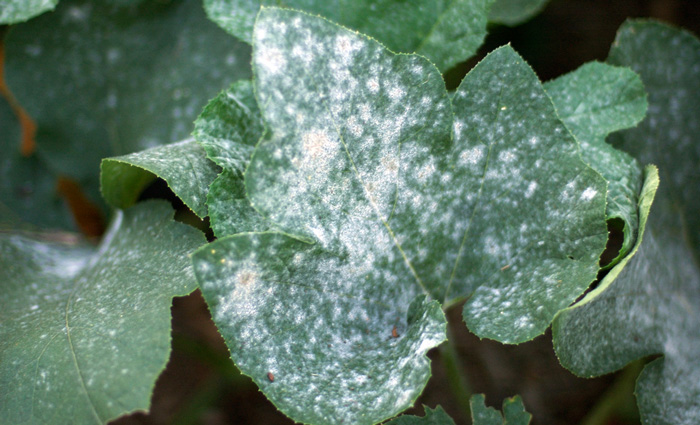
What causes powdery mildew?
Unlike the majority of fungal diseases that require moisture and humidity, powdery mildew needs warm and dry conditions to thrive (although humidity around the plant itself has to be relatively high). The fungus will not spread in cool, rainy areas.
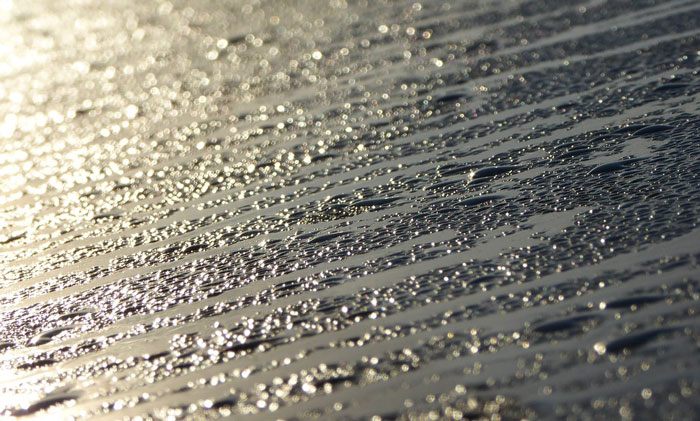
With all this in mind, we can easily conclude that this type of mildew is able to spread in many different conditions.
The main causes of powdery mildew are:
- High humidity. Because this fungus needs only small amounts of moisture to thrive, you can expect it to appear in any humid environment. This is particularly problematic for young cannabis plants since they need 40-60% relative humidity to grow.
- Poor airflow. If you have air circulating properly throughout your greenhouse or grow room, you have nothing to fear. However, when high humidity is combined with limited airflow, powdery mildew has all necessary conditions to thrive. So, if there is bad ventilation or no airflow in the area where you grow your plants, the spores will take advantage of the lack of fresh air to land on your plants and reproduce.
- Leaf-to-leaf contact. When the leaves of your plants touch each other, moisture forms between them. To prevent this, you can prune some of the leaves or space plants farther apart from each other so that their leaves never touch.
Is powdery mildew harmful?
Although white powdery mildew does not pose a direct threat to humans, it can be indirectly harmful.
It won’t hurt you if you touch it, but if you are allergic to mold and you pick or consume a plant infected with mildew, you can have a serious reaction to it.
Your plants are the ones that are most affected by powdery mildew. As we already said, this fungus can infest a variety of plants, from grass and flowers to vegetables, fruits, grains and even cannabis.
This type of mildew can prevent your plants from blooming, and can even kill them. If an infected plant does manage to produce fruit, it will most likely be smaller and it will have a dull and inferior taste.
If you’re in Montreal, we offer mold inspection, mold testing, and air quality testing services to help you keep your plants healthy.
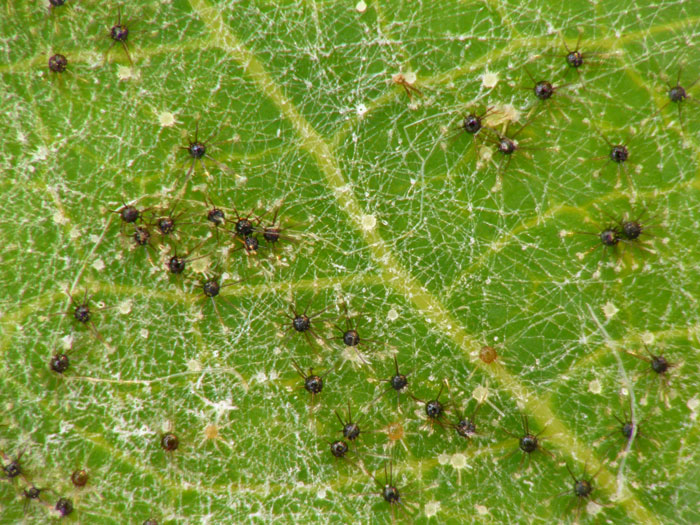
Is powdery mildew systemic?
This is one of the most common questions we get. A number of people who grow plants, particularly cannabis growers, have been debating whether powdery mildew is a systemic pathogen or not.
But first, let’s explain what “systemic” actually means.
Systemic pathogens spread through a plant’s vascular system, while superficial pests spread across the surface of the plant.
Even though the debate is fierce, the most experienced growers claim that powdery mildew is not a systemic fungal pathogen. It does not reproduce in the plant cell—only on the surfaces of the plant, such as the stem and leaves.
Nonetheless, this does not completely eliminate the threat this fungus poses to your plants. As soon as you notice it, you should take appropriate steps to control and prevent it.
Where does powdery mildew grow?
Powdery mildew can grow in any place where it finds favourable conditions. This can be a field, garden, greenhouse or grow room.
Besides being able to grow in a wide variety of environments, it can affect a number of different plants, such as:
- cucumber
- zucchini
- tomato
- rosemary
- peonies
- barley
- cannabis
- roses
- grass
Below, we will list certain plants that are particularly affected by this fungus along with the tips on how to prevent it from getting the best of your crop.
Powdery mildew on cannabis
Have you noticed white spots on your marijuana leaves recently? If yes, you may want to visit your grow facility and ask about powdery mildew.
What is white powdery mildew that grows on cannabis?
As we mentioned earlier in this article, white powdery mildew is a fungus that grows on many plants, including cannabis. As a matter of fact, this contaminant is among the most destructive fungal pathogens for cannabis.
The organisms responsible for the growth of powdery mildew on cannabis are Leveillula taurica and Podosphaera macularis.
How does powdery mildew spread on cannabis?
In general, mildew attacks the youngest plants first. It spreads across the entire plant, ruining the stems, leaves and buds of your plant.
If you notice a damp smell coming from your buds, your marijuana has likely been affected.
It is best to act before the fungus invades the bud; otherwise, the reproduction process cannot be reversed.
When the mildew reaches advanced wwws of growth, it will make your cannabis plants go yellow first. The plants will then become brown and, eventually, they will simply die.
This could mean the end of your dreams of becoming a successful marijuana grower. That is why you need to make sure you are constantly inspecting your plants and paying attention to any unusual changes.
What causes powdery mildew on cannabis?
This fungus often affects cannabis plants since grow rooms have to be very humid. In addition, grow rooms sometimes have bad ventilation, which reduces proper airflow and generates perfect conditions for mildew growth.
Also, if your cannabis cultivation facility is overcrowded with marijuana plants, leaves will touch other leaves, which will help powdery mildew to spread, making it even harder for you to eradicate the problem.
Is powdery mildew harmful to smoke?
When you smoke moldy cannabis, you are sucking in thousands or millions of mold spores. Does this sound safe?
Of course smoking mildew-contaminated marijuana is harmful. If you do this, you will inhale a number of dangerous toxins, which can seriously damage your immune system. And this is only one of the reasons to get rid of powdery mildew on cannabis.
How to get rid of powdery mildew on cannabis (DIY solutions)
The best way to make sure this contaminant does not take a toll on your plants is to protect your plants right from the start.
If you want to know how to get rid of powdery mildew, here are some tips:
- Make sure that plants have plenty of space in the room where they are growing. This will prevent the mildew from spreading from leaf to leaf.
- Improve ventilation in your grow room. This will give your plants enough fresh air and stop the contaminant from spreading. However, it is best to leave this to professionals.
- When watering your plants, make sure that they get at least five hours of light after that, be it natural or artificial. If you want it to be natural light, you have to water the plants shortly after noon.
- Prune the fan leaves that do not receive enough direct light because of shade.
- If you’re growing marijuana indoors, you can use a UVC light to detect any missed spores from spreading any further.
Moreover, you can spray different kinds of DIY solutions on your plants. However, this will work only if your plants are just slightly contaminated with mildew.
Here are some examples of DIY mixtures you can prepare:
- milk
- baking soda
- apple cider
- hydrogen peroxide
We will explain how to apply each of these DIY solutions later in the article.
*Please note that we don’t give any guarantee that these DIY solutions will help you and we disclose ourselves from any damage impacted by using them.
How to remove powdery mildew on cannabis (the right way)
If you fail to prevent mildew from growing on your marijuana or if you are unable to remove it once it has already started growing, you risk losing your entire crop, which means all your work has been in vain.
For this reason, it’s best to let professionals take care of your mildew problem.
For optimal results, you should leave inspection, mold removal, grow room ventilation setup and other complicated procedures to experts.
To get your grow area inspected and your mildew removed by professionals, call Mold Busters. We also offer virtual inspection services for your convenience.
Powdery mildew on roses
If you are a professional gardener or just like having roses in your garden, you know that they are delicate flowers, especially in early growth phases.
In order for your flowers to be healthy, you need to keep them safe from various toxic parasites such as powdery mildew.
What is white powdery mildew that grows on roses?
The organism that is responsible for powdery mildew on roses is called Sphaerotheca pannosa var. rosae.
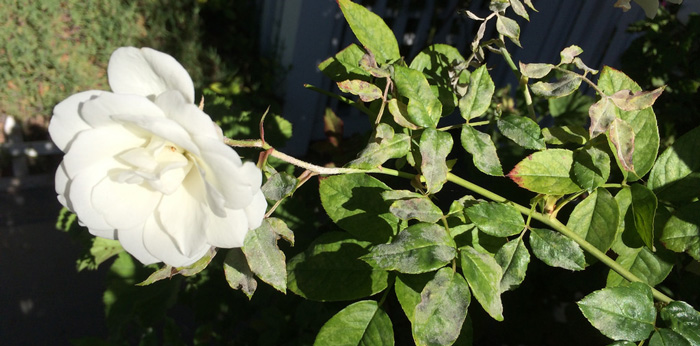
It forms a white powder over the surface of rose leaves, sometimes even spreading to the stem and new rose buds.
It causes disfiguration of the rose leaves and blooms, preventing the buds from opening.
What causes powdery mildew on roses?
This fungus is commonly grows on roses when warm, dry days are followed by cool, humid nights. If you are not careful, it won’t take long for it to spread to your entire garden.
How to treat powdery mildew on roses (DIY solutions)
Similarly to cannabis, you can use a few DIY mixtures to protect your roses:
- milk
- baking soda
- fungicide
*Please note that we don’t give any guarantee that these DIY solutions will help you and we disclose ourselves from any damage impacted by using them.
How to remove powdery mildew on roses (the right way)
Again, trying to apply DIY solutions will only protect your roses up to a certain point.
To ensure that your roses are truly safe and protected, it is necessary to consult experts, especially if you grow your flowers in a greenhouse, where the air is not as fresh as outdoors.
To make your gardening a bed of roses easier and safer, contact Mold Busters today.
Our mold removal services are available in Ottawa, including specialized air quality testing and mold inspection and testing.
Powdery mildew on buds after harvest
No cannabis grower wants to see powdery mildew on buds after harvest.
In fact, the harvesting process itself can spread the spores to uninfected plants.
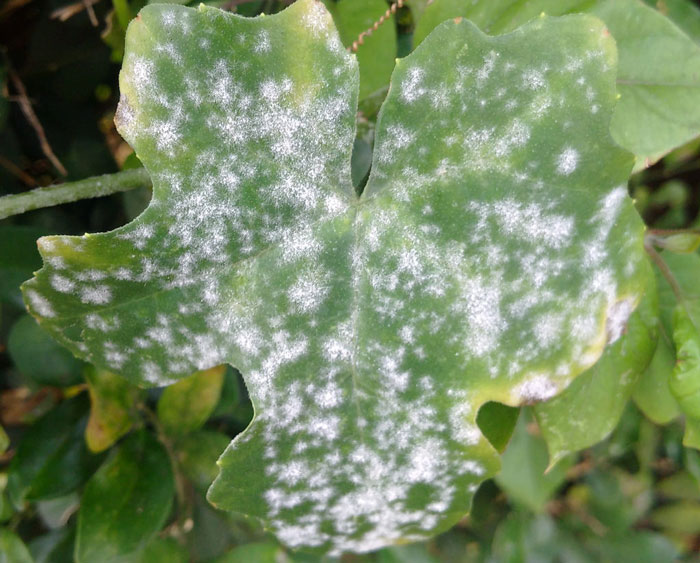
And once mildew is on the buds at harvest time, there is not much you can do to fix the problem.
What causes powdery mildew on buds?
The same fungal pathogens that cause powdery mildew on the stem and leaves of cannabis plants are responsible for powdery mildew on the buds, namely Leveillula taurica and Podosphaera macularis.
The fungus will first grow on young leaves of mature plants or on younger plants. After that, it will spread to buds.
How to remove powdery mildew from buds (DIY solutions)
Having powdery mildew on marijuana buds is a real catastrophe because there is very little you can do at this point.
There are only a few ways to remove mildew from the buds.
- You can try to remove the infected plants from the grow area by bagging them up.
- You can cut out the infected leaves and buds in a plastic bag (if the plants are not severely infested).
However, if the fungus has spread to other plants, cutting and removing the infected buds and leaves is practically all you can do.
How to remove powdery mildew on cannabis buds (the right way)
Once plants get infested, it won’t take long for mildew ruins the entire crop. That is why you need to prevent it before the infestation takes hold.
For this, you need a team of experts to inspect your grow facility for proper air quality and other conditions. Only then will you know what exact steps you should take to solve the issue effectively.
Powdery mildew on grass
Even though this may sound impossible, even grass can be affected by powdery mildew.
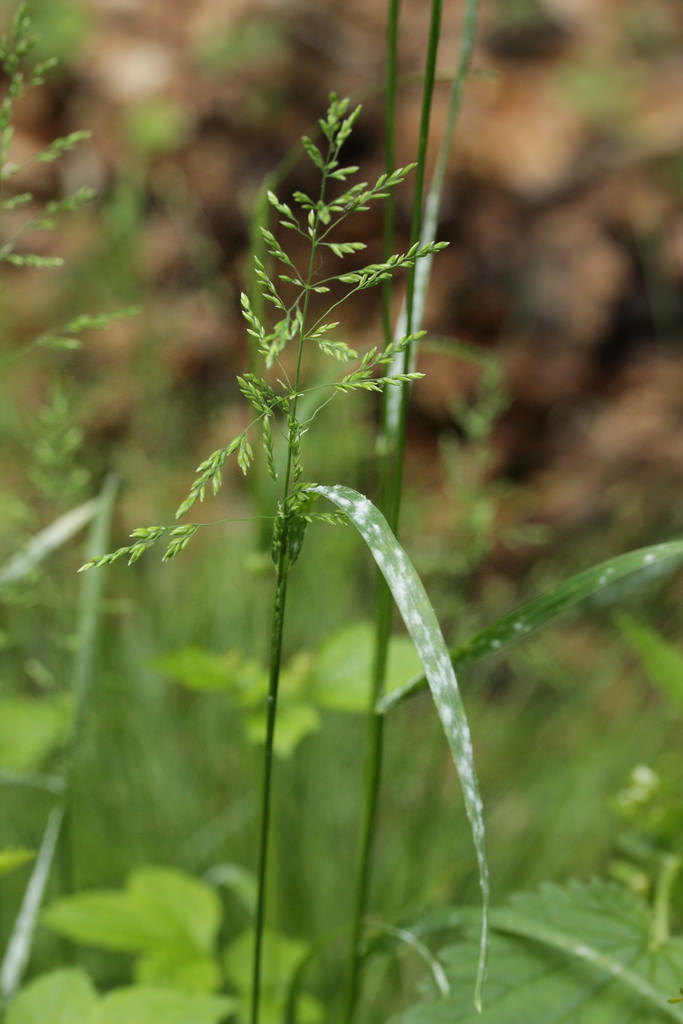
As you can see, this fungus is everywhere. In fact, it may be hiding in your lawn as you read this article.
What is white powdery mildew that grows on grass?
The name of the fungus pathogen that affects grass is Blumeria graminis (also known as Erysiphe graminis).
It is responsible for the powdery mildew that appears on various grasses and cereals.
What causes powdery mildew on grass?
Powdery mildew will appear on grass that grows in poor conditions.
Some of the causes can be:
- drought
- compacted soil
- overwatering
- improper mowing
- weather conditions
How to treat powdery mildew on grass (DIY solutions)
To remove powdery mildew from your lawn, you can take the following steps:
- spraying fungicides
- watering early during the day so that the grass has enough time to dry before nightfall
- opening up the area to allow better air movement and more sunlight
- reducing the amount of nitrogen fertilizer that you use in shaded areas
- allowing the grass in shady areas to grow a little taller than the rest of the lawn
*Please note that we don’t give any guarantee that these DIY solutions will help you and we disclose ourselves from any damage impacted by using them.
How to remove powdery mildew on grass (the right way)
Can you say with certainty which of the causes is responsible for the mildew growth on your grass?
Furthermore, are you sure that you can remove this fungus effectively?
To save your time and energy, and to be sure that the mildew is removed properly from your grass, you will need professional mold remediation technicians like Mold Busters who have over 10 years of experience identifying and treating mold problems of all sorts.
How to control and prevent powdery mildew growth
So far, we have listed a number of ways to prevent and control powdery mildew from forming on your plants such as ensuring adequate ventilation, giving your plants enough space to grow and pruning.
But there are also a few mixtures that you can use to control this fungus. As promised, we will now list a few DIY mixtures that can help you treat powdery mildew on different plants.
*Once again please note that we don’t give any guarantee that these DIY solutions will help you and we disclose ourselves from any damage impacted by using them.
Baking soda (for cannabis and roses)
To create a baking soda mixture, combine:
- 1 tablespoon of baking soda
- ½ spoon of liquid soap
- 1 gallon of water
Water the leaves of your plants a couple of days before applying the mixture, and do not apply it in full sunlight. Try on a small area first to see how the plant will respond.
Milk (for cannabis and roses)
Use a 40:60 milk-to-water dilution and spray biweekly.
The salts and amino acids found in milk seem to kill the fungus and help the plant’s immune system.
Apple cider vinegar (for cannabis)
Another DIY solution to consider is apple cider vinegar.
Mix 4 tablespoons of organic apple cider vinegar with 1 gallon of water.
Mist the mixture onto your plants every three days to destroy the mildew and prevent it from growing back.
Hydrogen peroxide (for cannabis)
Pour the following ingredients into a one-gallon spray bottle:
- 1 quart of standard 3% hydrogen peroxide
- 3 quarts of water
Shake the spray bottle and spray the mixture onto your plants, focusing on areas infested with powdery mildew. Repeat this process every day until the mildew disappears.
Fungicide (for roses and grass)
There are a number of off-the-shelf fungicides that can treat powdery mildew effectively. One of them is chlorothalonil, which is strong and effective but leaves a white milky film on the leaf surface.
You can try any of these solutions today and see how your plants react. However, always keep in mind that DIY solutions can only partly prevent powdery mildew growth.
If you want to know what causes powdery mildew in your garden or grow room and to find the best way to solve this issue, you have only one option—ask experts for help.
The Mold Busters team has 19 years of experience in mold testing and removal, grow op remediation, odor control and other mold-related procedures.
When you ask us for help, we will conduct a detailed inspection and implement the best solution for your situation.
Contact Mold Busters today to stop powdery mildew from further damaging your plants.
Conclusion
Powdery mildew grows on many different plants and causes serious problems in gardens, fields and grow facilities. It usually thrives in small spaces with high humidity and insufficient airflow.
There are various solutions you can try today to remove this persistent fungus, from leaving more space between plants to applying some of the DIY anti-fungal mixtures.
When you use these methods, however, you can never be certain that you have removed the mildew completely.
The only option that guarantees success is a professional mold inspection and mold removal conducted by a team of experts. When you call us, you will know everything about the mildew on your plants—from what caused it to how to prevent it completely.
Get rid of powdery mildew for good and call Mold Busters today.
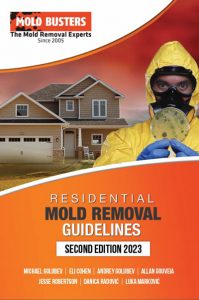
Get Special Gift: Industry-Standard Mold Removal Guidelines
Download the industry-standard guidelines that Mold Busters use in their own mold removal services, including news, tips and special offers:
Published: November 12, 2021 Updated: December 22, 2023

Written by:
John Ward
Account Executive
Mold Busters
Fact checked by:
Michael Golubev
CEO
Mold Busters

